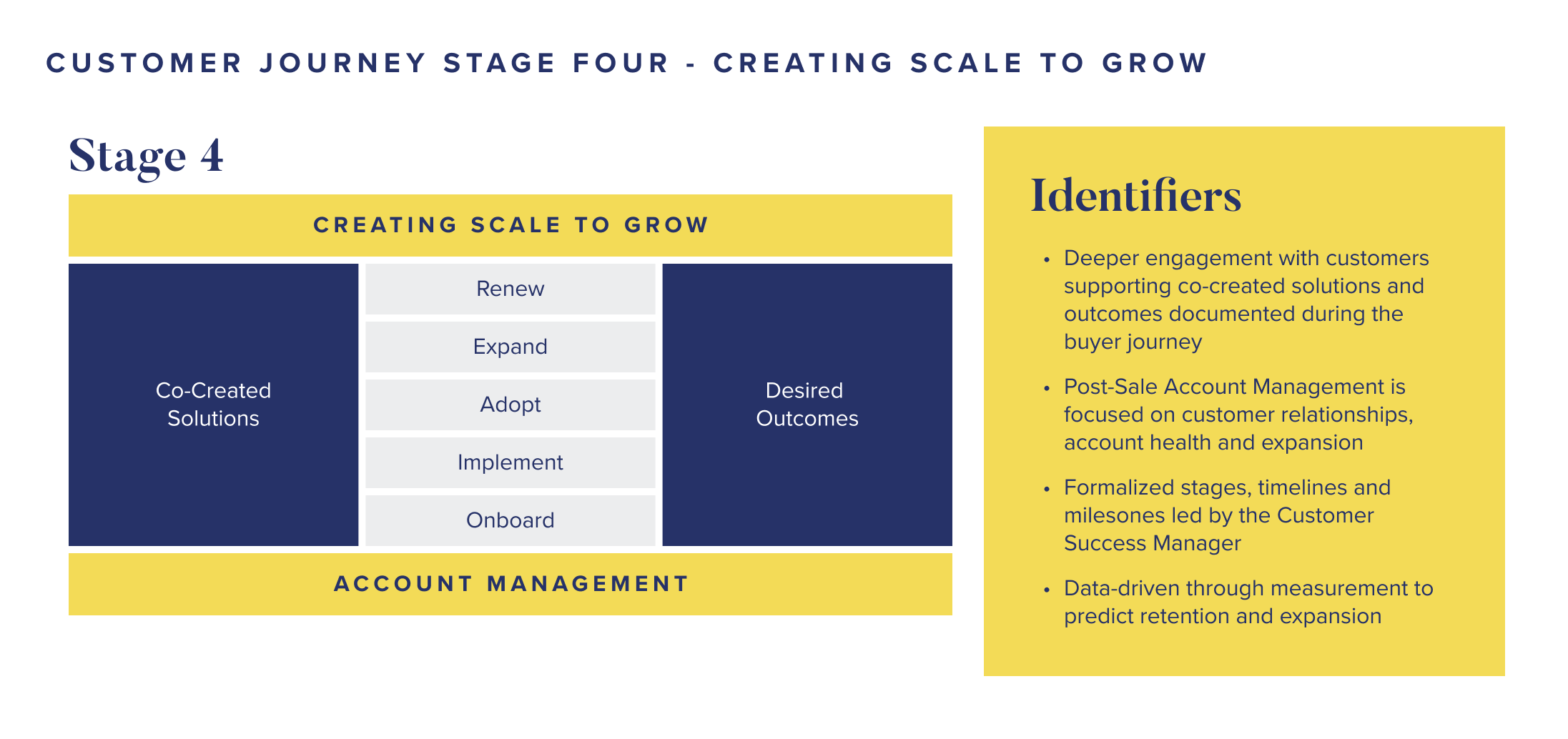
Building Customer Success Into Your Company’s DNA: Part Two
In our last blog, we discussed the first two stages of building Customer Success DNA in the early stages of your business. As a quick recap, the first stage can be a testing and learning phase as companies seek product-market fit, while the second stage builds on that work by finding solution-market fit — a process of working closely with customers to ensure the product reflects how it’s actually used.
With these foundations, the guide below will focus on creating scalable growth with your customer journey.
Customer Journey Stage Three – Accelerating Time to Value

At this stage, you have a deeper understanding of your customers’ goals, problems, needs and desired outcomes. This is a key “crossing the chasm” moment that moves your customer success strategy from good to great and prioritizes activities that expand relationships and provide preventive customer health — or, the opposite of fire-fighting.
Why CRO and CCO leadership is critical
The CRO and Chief Customer Officer’s leadership is the bridge between buying and a successful customer journey. Alignment between these two accelerates time to value.
I’ve seen great Chief Customer Officers build successful customer journeys in a number of ways. For example, Alberto Rodrigues from Armis, a Georgian portfolio company, uses an early warning system (EWS) process that includes monitoring, customer health reporting and weekly executive engagement. This integrates the voice of the customer into the company’s leadership team and drives world-class net promoter scores while scaling to support rapid growth in customer acquisition.
Have roles to support the organic customer journey
An organic customer journey is usually in place at this stage, including account transition, onboarding, implementation and ongoing troubleshooting.
Normally, the journey is defined by specialized roles that help customers at every stage of the adoption cycle:
- Customer success = account management and onboarding.
- Professional services = implementation and deployment.
- Customer support = product troubleshooting and help centers.
With an established customer journey, companies can capture best practices for repeatability and building packaged service offerings.
We encourage our portfolio companies to define value and solutions during the sales process to empower the customer success, professional services and customer support teams to create packaged offerings that support specific customer segments.
A common challenge at this stage is having a highly successful customer success plan and scalable customer support across both large and small customers. To prepare for this, I’ve seen companies create tiered customer success and services offerings — strategic or complex accounts receive high-touch support, while smaller accounts can be serviced by self-service options or automation.
As you grow, it is possible to provide the same value of service to your customer, but it shouldn’t have to be all high touch.
Customer Journey Stage four – Creating scale to grow

The customer success team as collaborators
So far, this blog has focused on the GTM teams and what is in their control to make customers successful. If your GTM team is dialed in and working effectively across both the buying and customer journey as described, product and marketing teams can focus on pipeline generation and the product roadmap, further supporting customer success teams.
Distinguishing your customer success team as collaborators with product and marketing ensures your service offerings can keep the customer feature backlog manageable, and having product, engineering and marketing work together can accelerate your customer engagement capability.
Creating scale for growth depends on three elements, which we will cover in the next several sections:
- Formalizing your customer journey.
- Ensuring GTM capacity exists to support both customer adoption and account management post-sale.
- Data-driven metrics from the customer journey to predict retention and expansion.
As your GTM teams expand around customer success, they can collect broader product feedback that turns into targeted and co-created customer solutions.
I’ve seen companies at this stage build a product feedback loop with the field success, services and product management teams, who can work together to inform the product roadmap outside of closing deals. This is a great place to start. Inexpensive product roadmap software can be a good choice to use for ideation and setting the dialogue on how teams create solutions versus features.
Formalizing the customer journey
In the previous stage, we mention that the customer journey is defined by specialized roles. Now it’s time to formally define customer journey stages based on what the people in these roles have learned.
Defining the stages of your customer journey allows you to measure engagement, timelines, milestone achievement and internal ownership. We have already highlighted some of the most common customer journey stages: onboarding, implementation, adoption, expansion and renewal.
Like previous stages, metrics are important for this process. Your team should have the necessary operational support and tools to collect, measure and report on the customer journey.
It is not considered a best practice to custom-build analytics on top of your customer relationship management software to measure the customer journey. The complexity is much greater than managing account opportunities. Instead, consider a customer success or customer experience platform (CDP).
You should also get insight from account managers to inform how to measure key inputs — including relationship maps, success plans, time to onboard, time to first value and product usage patterns — that create value and world-class net dollar retention.
With these metrics in hand, you can create a data set that can start predicting retention and expansion. What starts as tracking customer health can quickly expand in a machine learning led early-warning system (EWS), which ensures you’re informed of major customer events and can respond proactively.
Increasing GTM Capacity
We have mentioned account management several times. At a certain point of growth, executing the customer journey and account management through a single customer success role could be strained. The evidence of this challenge could materialize in lower gross dollar retention (GDR) or a decreased ability to expand.
Account management roles in this stage sit with account executives, customer success managers, technical account managers and a plethora of role titles. No matter the title, ensure that you are building decision-making and influencer contacts at your customer’s company, while meeting expectations and milestones set during the buying process.
Leadership and execution will set you apart
Companies can exhibit different characteristics of all four stages at any point in time. We see many successful companies with a dialed-in, stage four customer success process at $10M ARR and many performing just as strong at stages one, two and three.
Using the stages discussed in these blogs can provide good insight to inform your GTM strategy and resource investments and act as a helpful baseline to measure against. However, with all teams, it is how leadership and execution decide to come together.
The Georgian customer success team supports our entrepreneurs and their teams with nurturing and coaching on value creation, GTM, customer journey and operational acceleration workshops. Our workshops help our CoLab and portfolio companies strengthen their go-to-market and customer success capabilities to accelerate growth timelines.
Read more like this
How to Shift Your Company to an Enterprise Model
As the annual invite-only Scaletech Conference continues, bringing together leaders and experts…
Lessons from Leslie Fine: Board meetings, scaling sales teams, storytelling
Networking with industry leaders is key to evolving your business. These connections…
How To Strengthen Your Personal Brand With Hamza Khan
If you’re not telling your story online, someone else is, and there’s…